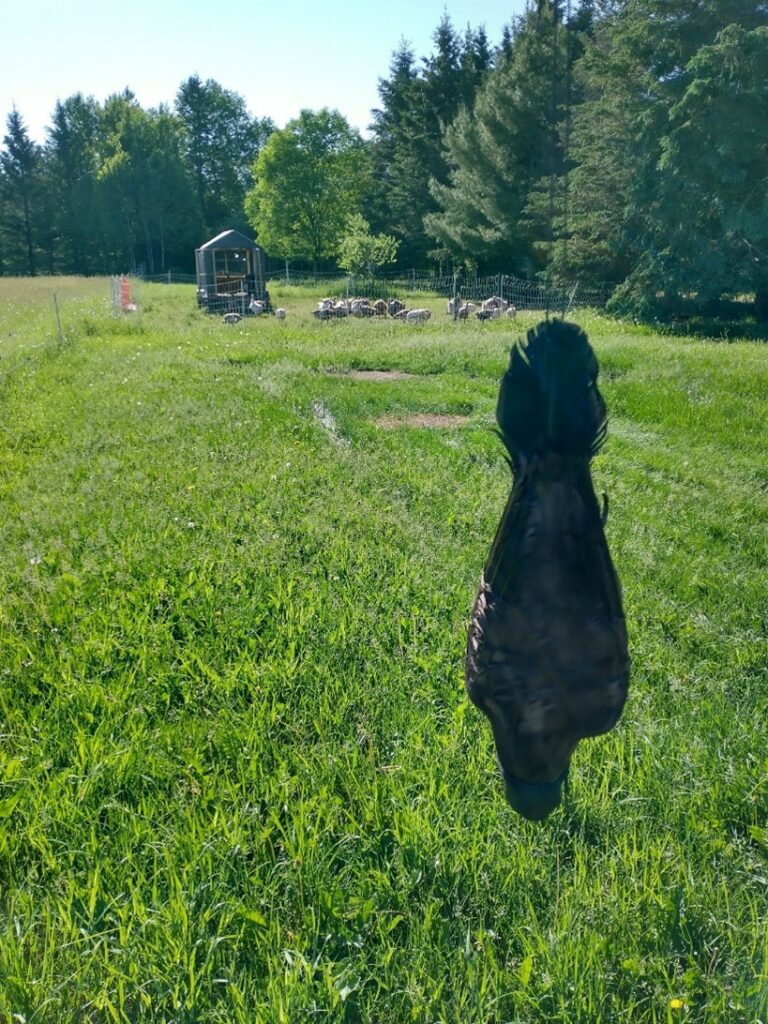Challenge with Ravens

Thieves. That’s what they are, thieves! Especially when they have young ones to feed.
Lately, those young ones aren’t so small anymore—flitting amongst the treetops squawking like monkeys and still expecting their parents to feed them. By their size, it would appear that these teenaged corvids could very well feed themselves, but that’s obviously not their opinion!
Each day, the parents scope out the pig pens, looking to see if any tasty morsels of grain or kitchen scraps have been left behind. But their absolute favorite items to snatch are eggs. I’ll be weeding in the garden and look up to see the oversized black silhouette flapping overhead, the telltale orb carefully clenched in its beak.
“Darn you!” I holler at it, frustrated once again to have an egg stolen.
Their favorites are turkey eggs—of course the biggest of them all—which are white with brown speckles. It’s amazing the ravens can fit them in their beaks at all! Turkeys in their cluelessness often randomly lay their eggs about their yard, and this makes for easy pickings for the ravens, who have even learned to wait in nearby pine trees to nab eggs as soon as they are laid.
Having the ducks in their new hooped tractor means that the ravens can’t reach their eggs (haha, take that, thieves!), so no more snitching duck eggs, but the turkey and chicken situation has remained a problem. We’ve tried flashy stripping, whose glare and snapping sound is supposed to scare away ravens. Instead, it scared our chickens and the ravens appeared to be thinking, “Ooh, shiny, did you bring that for me?”
Ravens were learning to fly into the mobile summer chicken coops, steal eggs, and then fly off. So, we tied sheets onto the door openings to flap and block off most of the space. They’re high enough that the chickens can walk in underneath, and while occasionally a raven will also land and walk in, at least this has deterred the “flap and run” snatching.
But the harvesting of turkey eggs was so epic this year that (combined with the odd spring weather) there weren’t enough left for me to incubate for raising Thanksgiving turkeys. Darn it! We had to find another way to deter these naughty birds. Go and find something else to feed your young!
Ravens are incredibly smart. They know when our sheepdogs are loose and when they are in their pen. They know when you’re out with the pellet gun looking for ground squirrels and when you haven’t anything more dangerous than a stick or rock to throw at them. And they know when you’re done with chores and the coast is clear for them to steal as many eggs as they can carry. It’s frustrating! They even killed and ate one of my older hens, who was unable to escape their advances.
The old timer farm method would be to shoot one and hang its carcass up as a deterrent to the other birds. It is not unlike the medieval theory of curbing unwanted behavior by impaling the heads of enemies on spikes along the castle walls. It’s terribly macabre and sound like an invitation to draw in the coyotes (nothing like the smell of death to entice these undesirables), so we were looking for an alternative solution that might play into the psychology of the original.
And it turns out we weren’t the only ones with this interest. You can purchase dead raven decoys—and they look fairly realistic with shiny eyes, feet, and beak, and cladding in real feathers. We purchased two: one for the turkeys, and one for the hens, hanging them from ropes dangling from bird feeder poles.
The chickens and turkeys seemed to pay no mind to this decorative addition to their homes, but the ravens noticed immediately. They cawed and circled, eyeing this display of false carnage. For four days, the ravens stayed away (likely casing the neighborhood to see who had been slain), which was the most dramatic deterrent of behavior we’ve seen so far.
Now we sit at a partial truce, with less egg stealing and the fake ravens still on guard. So much of farming in the midst of wilderness is finding a balance with nature. I understand that the ravens have an important role to play in our environment, and that their children are hungry. But I also want my eggs and birds to be safe. So, we strike a compromise and learn to work with each other as best we can.
Ravens are tricksters, and it feels rather poetically justified to play tricks back on them with these decoys. Perhaps next year I’ll try fake eggs, and then they’ll be frustrated and leave the real ones alone. It might be worth a try! Not unlike the idea of setting out stones painted like strawberries near strawberry plants to frustrate birds that want to eat the berries and causing them to leave the real ones alone.
Who are your wildlife thieves? How might you be creative in deterring their mischief? Remember it’s a balance, as they call this place home too. Now it’s time to collect some eggs before the ravens get there first. See you down on the farm sometime.





